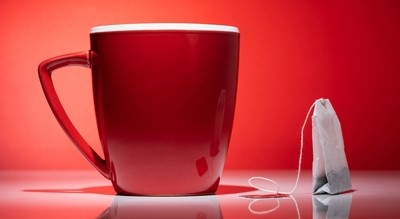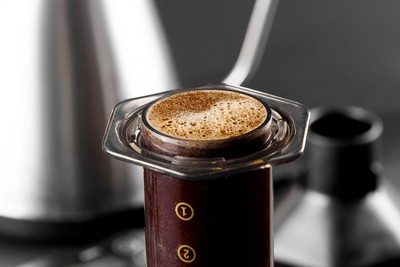Why Does Coffee Have Caffeine? (Coffee’s Secret Weapon)

Over two billion cups of coffee are drunk every day, in part due to the stimulating effects of its caffeine on our bodies. But why is it that coffee contains caffeine?
Caffeine is a natural pesticide used by the coffee plant to protect itself from pests. Caffeine also protects it from other competing plants. However, caffeine stored in the coffee flower nectar actually attracts pollinators, creating an olfactory memory that makes the pollinators proritise the coffee plant.
But there is one pest that actually thrives on caffeine, and this is a huge problem for the coffee plant.
The two reasons why coffee has caffeine
Caffeine is an alkaloid that occurs naturally in some 60 species of plant, one of which is the coffee plant of the Coffea genus.
Caffeine is found in varying levels in all parts of the plant. It serves to both protect itself from pests and to attract pollinators.
1. Caffeine provides protection from pests
Caffeine runs throughout the entire caffeine plant, being stored in the stem, leaves, flowers, coffee fruit, and the seeds inside the coffee fruit. The highest concentration of caffeine is in the seeds (beans).[1]
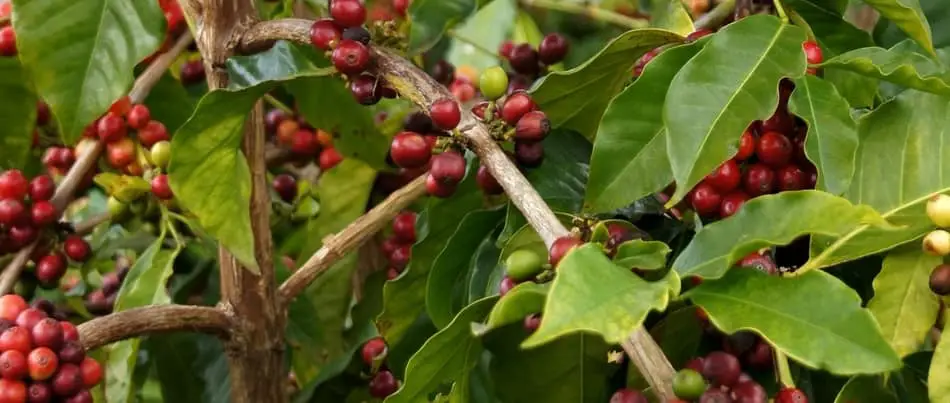
Caffeine is bitter-tasting and toxic to many insects when consumed in large doses relevant to their size.
Caffeine causes the nervous system of herbivorous insects to stop producing essential enzymes. At large enough doses, the enzymes are inhibited in the insect, causing paralysis and eventual death.
The levels of caffeine in coffee plants vary by species. Over 98 percent of the coffee consumed worldwide comes from just two varieties.
The first is Coffea arabica, better known as arabica. Arabica accounts for between 60 – 70 percent of all the coffee produced worldwide. Arabica is superior in taste, creating the most delicious coffee drinks.
The second is Coffea canephora, better known as robusta. Robusta accounts for the majority of the remaining 30 – 40 percent, and mainly goes into producing low-grade coffee such as instant because of its inferior taste.
Arabica coffee has around half the caffeine content of robusta. Because robusta contains so much more caffeine, the plant is able to survive at lower altitudes where a greater number of pests live.
Robusta can even grow at sea level although most robusta is grown at elevations between 200 – 600 metres (650 – 2000ft).
In order to survive, arabica has to grow at far higher elevations where there are fewer pests. Typical elevations for arabica are anywhere between 1000 – 2000 metres (3250 – 6500 ft) above sea level.
Another use of caffeine in coffee plants is to protect itself from competing plants.
When the leaves and cherries fall the ground, they release small amounts of caffeine into the soil that can inhibit the growth of other seeds, thus giving their seedlings a competitive advantage.[2][3]
2. Caffeine attracts pollinators
The second reason that the coffee plant produces caffeine is definitely a surprise. The flowers of the coffee plant produce nectar that contains low doses of caffeine, which bizarrely serves to attract pollinators.
At first glance, it would seem counter-intuitive for the coffee plant to produce caffeine in its nectar as caffeine is bitter and toxic to most pests.
Harming or deterring the pollinators that it relies on for its survival, especially honey bees that are adept at detecting and avoiding toxins, would not seem like a good idea.
But as we know with nature, everything is in place for a reason. Studies have already shown that low doses of caffeine activate the reward system in human brains, which contributes to its addictive nature. So, could the same be true for honey bees?
This question led Dr Geraldine Wright and her team from Newcastle University (UK) to carry out a study to find out why the coffee plant produces nectar in its flowers.
The team trained honey bees (Apis mellifera) to associate a floral scent with sugar solutions dosed with seven different quantities of caffeine to test the bees’ long-term memories.
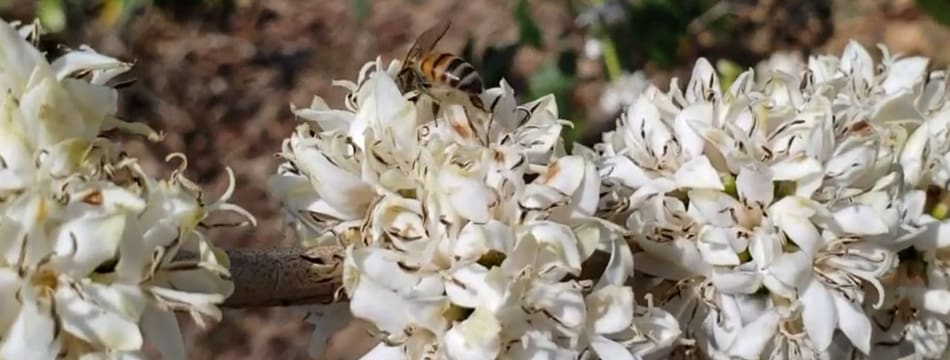
Even at the lowest doses, the caffeine had a profound effect on the long-term memory of the bees.[4] And when the sugar solution contained levels the same as that of the nectar in coffee flowers, the results were remarkable.
24 hours later, three times as many bees demonstrated their recall of the scent by sticking out their tongue in order to receive the caffeine reward. And more remarkably, twice as many were able to recall the scent 72 hours later.[2]
Caffeine was shown to change how neurons in the bees’ brains responded to learning and memory tasks. This enables the coffee plant to pharmacologically manipulate the honey bees’ behaviour.
When honey bees learn to associate the coffee plant’s floral scent with food, they are more likely to return to those flowers. This increase in foraging efficiency leads to more effective pollination.[5]
Because of the bees’ fidelity, the coffee plant reaps the reproductive benefits by producing more fruits and seeds.[4]
The tests also showed that the levels of caffeine contained within the nectar were the perfect amounts to attract the honey bees.
It was found that the bees were deterred from drinking sugar solutions containing caffeine levels that were higher than that of the nectar.
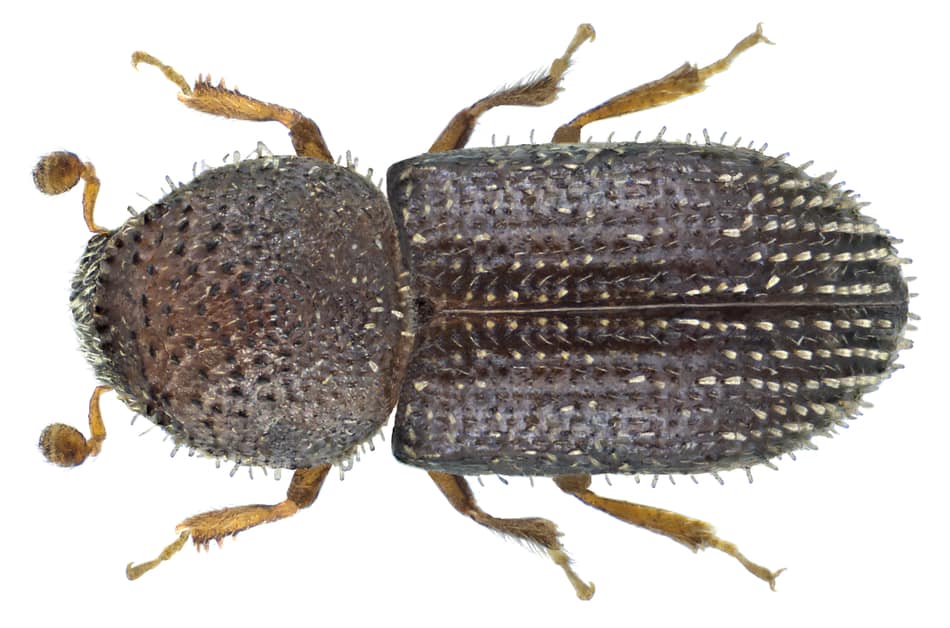
Coffee berry borer beetle
The coffee borer beetle (Hypothenemus hampei) is one insect that isn’t deterred by the coffee plant’s natural caffeine. In fact, it’s the only creature on earth that can feed solely on coffee beans.[6]
The beetle, which is native to Africa and just a few millimetres long, is the most devastating pest of coffee worldwide, with its infestations capable of decreasing crop yield by up to 80 percent.
Unfortunately, it’s not only found in its native Africa. Due to being accidentally introduced, the beetle is now present in almost all coffee-producing countries worldwide.[7][8]
The coffee borer beetle lives inside the coffee fruit (coffee cherry) and feeds on the seeds (coffee beans).
The females bore holes into the coffee cherries, laying their eggs in the seeds (beans). When the larvae hatch, they consume the beans. The beans of the coffee plant contain the highest levels of caffeine of all.[9]
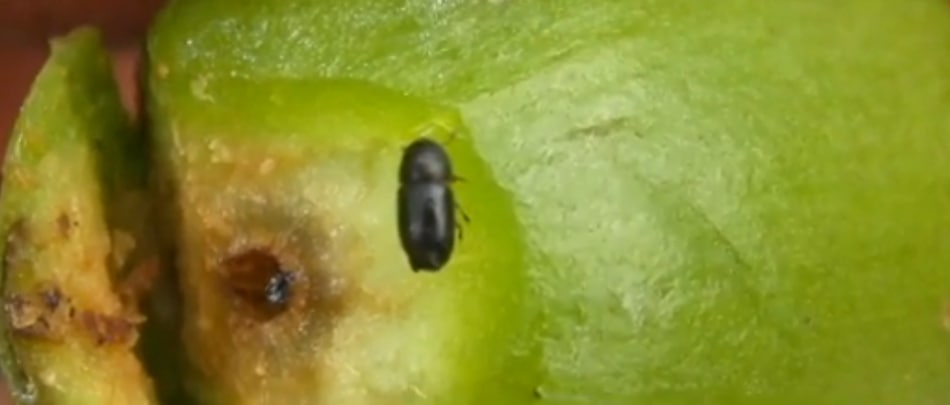
The beetles are able to consume the equivalent of 500 espressos, a level so high that it would kill a human. So how is the beetle able to survive?[10]
The secret is in the beetle’s gut bacteria which detoxifies the caffeine.
Javier Ceja-Navarro, from the Lawrence Berkeley National Laboratory in the US, conducted a study to find out how exactly the beetle is able to consume such large quantities of caffeine.
When he analysed the beetles’ faeces, he discovered that it contained no traces of caffeine whatsoever. Something in the beetles’ guts had seemingly destroyed the toxic substance.
As bacteria in the gut seemed the likely candidate, he fed the beetles with antibiotics. Now, the beetles were not able to metabolise the caffeine, which was shown by their caffeine-laden faeces.[9]
Though the beetles survived, their capability to produce eggs and larvae declined by 95 percent. Most of the eggs and larvae that were born died straight away, and for those that didn’t, none made it to adulthood.[6]
It was eventually identified that the caffeine-digesting bacterium Pseudomonas fulva was responsible for the metabolising of caffeine in the beetle’s gut.
When reintroduced to the beetles’ diet, they again found that their faeces contained no traces of caffeine.[6]
The fact that the borer beetle thrives off the caffeine contained within the coffee beans is devastating for coffee crops around the world. It’s extremely important for farmers to control any potential outbreaks.
Fighting against the coffee borer beetle
Workers on farms need to be trained to spot when crops show signs of infestations. Regular inspection is vital as the sooner the problem is spotted, the easier it is to deal with.
When crops are found to be infested, workers need to separate all the infected coffee cherries. Pesticides are essential in order to destroy the infestation.
Farmers are increasingly making use of traps made from recycled bottles. These bottles, which are painted red and filled with a combination of alcohol and used coffee grounds, fool the beetles into thinking that they’re about to burrow and feed on a delicious coffee cherry. However, once inside, they fall into the bottle and drown in the water at the bottom.
Caffeine’s effect on humans
Caffeine is a central nervous system stimulant that affects our bodies in numerous ways.
It’s safe for most healthy adults to consume up to 400 milligrams of caffeine per day.[11] That’s approximately six single shots of espresso, which goes to show how impressive the coffee borer beetle is.
When caffeine reaches your brain, the most notable effect is alertness, causing us to become more awake.
If you consume the same amount of coffee on a daily basis, your body builds up a tolerance to the caffeine. This often causes us to consume more and more.[12]
If you drink coffee purely for the stimulating effects of its caffeine, it’s best to only drink it when you most need it. That way, you avoid building up a tolerance, and you feel the stimulating effects of the caffeine.[12]
For those that consume large amounts of coffee, the sudden withdrawal of caffeine may cause:
- headaches
- anxiety
- irritability
- drowsiness
- tremors
Regularly consuming caffeinated coffee (not decaf) does have health benefits such as lowering the risk of developing Alzheimer’s and dementia, as well as cutting the risk of suicide by 45 percent.
Caffeine does cause your blood pressure to increase for a short period of time after consumption, but it isn’t thought that to cause any long-term effects.
However, those with irregular heart rhythms, or those suffering from hypertension, should consult a doctor to find out whether caffeine is safe to consume.
Caffeine also increases the acid in your stomach, which may cause heartburn or an upset stomach. It’s often claimed that cold brew coffee contains low levels of acid; however, this had been found not to be true. For those with a sensitive stomach, look to buy low acid coffee instead.
For women that are trying to get pregnant, the Mayo Clinic advises that you should limit caffeine consumption to between 200 and 300 milligrams per day.[13]
Because caffeine is a stimulant, it can cause your unborn baby’s heart rate and metabolism to increase. Too much caffeine can also cause slowed fetal growth and an increased risk of miscarriage.
In most cases, a little caffeine is safe during pregnancy. The current recommendation is 100 to 200 milligrams per day, which is about one small cup of coffee.[14]
For more information on caffeine content, make sure to check out my guide for a full breakdown.






